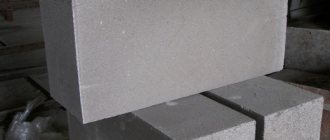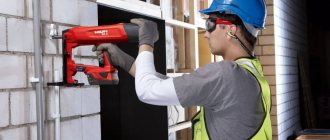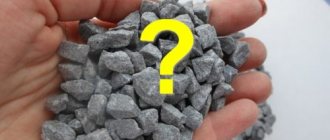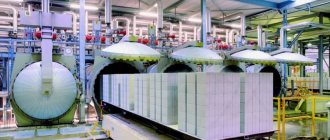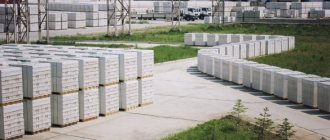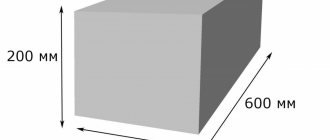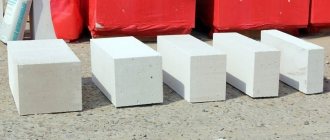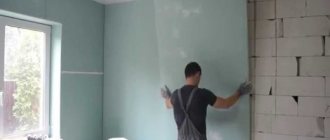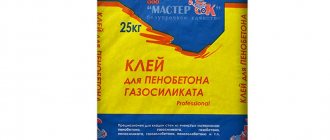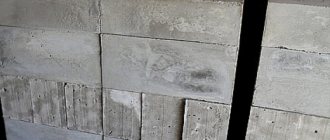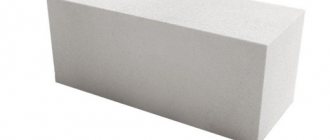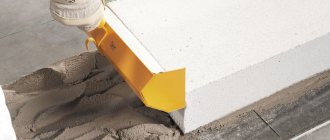| Place | Name | Characteristics in the rating |
| The best imported manufacturers of aerated concrete blocks |
| 1 | XELLA (Ytong) | Best foreign manufacturer |
| 2 | UDK | The most ideal geometry |
| 3 | Stonelight | High level of quality control |
| 4 | Bonolit | Best production technology |
| 5 | Hebel | Exact fit |
| The best Russian manufacturers of aerated concrete blocks |
| 1 | Aeroc | The largest Russian manufacturer |
| 2 | LSR | High performance |
| 3 | EuroAeroBeton | Best environmental performance |
| 4 | Sibit | The oldest Russian enterprise |
| 5 | GRAS | Attractive prices |
Nowadays, aerated blocks are increasingly displacing classic building materials such as ceramic bricks and wood from the market. Compared to them, it has a whole list of advantages:
- light weight, which significantly reduces the cost of building a foundation;
- high energy efficiency;
- low level of freezing;
- the ability to remove moisture from the pores;
In addition, nails and other fasteners can be driven into the foam block without pre-drilling. But, along with all the advantages, the difficulty of choice arises. There are many companies that produce aerated concrete blocks, and not all of them can boast of the quality of their products. And the requirements are important: strength, correct geometry, no shrinkage.
And this is just a small part. Achieving high quality is possible only with the most modern equipment, which not all manufacturers can boast of having. Therefore, we have selected for you the 10 best companies producing gas blocks, whose products meet the most stringent requirements. The rating included both foreign companies and local manufacturers, often not only not inferior in quality, but also ahead of imported brands. In addition, they are cheaper with all other characteristics being equal.
The best Russian manufacturers of aerated concrete blocks
Russian manufacturers have long been successfully competing with European brands in the building materials market. In addition, there are many more companies producing gas blocks in our country, but not all can boast of ideal quality. It should also be noted that some of the companies included in our rating operate on foreign equipment. These are independent brands, but the technologies are borrowed. If the first part of the top included brands that have production facilities in Russia, but with foreign origin, then here are exclusively local companies and only with the best quality.
What it is
Aerated concrete is a category of building material for the production of which sand, cement and a number of reagents are used, which turn into foam during interaction with cement. Often we are talking about a paste or powder made from aluminum. As a result of interaction with lime or cement, pores are formed. Bubbles are evenly distributed throughout the volume. Their shell consists of lime or cement. The raw material is called cellular because of its structure and is light in weight.
Features of choice
Every year technology improves and raw materials become cheaper. This is due to the production technology used and the cost of purchasing raw materials. A simple and, at the same time, inexpensive solution includes cellular concrete. Aerated concrete blocks are a type of porous concrete, which, in fact, is a subtype of artificial stone. It contains a number of cells. For production, a gas generator, cement and quartz sand are used. Gypsum, ash or lime may also be added. After prolonged exposure to temperature and high pressure, a series of chemical reactions occur that contribute to the formation of pores.
When choosing aerated blocks, you should pay attention to the following selection criteria:
Foreign companies
This category includes the most popular brands from abroad. All of them supply high-quality aerated concrete blocks to Russia, which have excellent performance characteristics and are suitable for a variety of construction work.
XELLA YTONG (Germany)
This famous German manufacturer produces a large number of different aerated concrete blocks. Many of them are produced at a plant located in the Moscow region.
XELLA YTONG is praised for its use of quality raw materials and unique processing methods. The company’s advantages also include the regular implementation of its own developments, which make it possible to obtain modules with the required set of characteristics.
Stonelight (Ukraine)
This company, representing the city of Brovary (Kiev region, Ukraine), produces high-quality and relatively inexpensive aerated concrete blocks. They are produced on a modern automated line under the close supervision of specialists.
Among other features of Stonelight’s work, it is worth highlighting the careful selection of raw materials and the availability of products in most retail outlets. The company's disadvantage is that it does not have the largest selection of aerated concrete blocks.
UDK (Ukraine)
Another Ukrainian manufacturer of building materials supplies high-quality aerated concrete blocks to Russia. They are manufactured using modern European equipment, which allows us to achieve the exact geometry of the modules and their optimal texture.
UDK maintains a competent pricing policy. In addition, the company attracts young specialists who develop themselves and help it reach new heights.
Bonolit (Germany)
This German brand is one of the world leaders in the number of sales of aerated concrete blocks. The latter are always distinguished by high quality, precise geometry and perfect texture.
Bonolit has many factories that employ only skilled workers. They operate modern equipment that allows them to produce gas blocks using any known methods. Among the company's shortcomings, buyers note the high cost of products, even in comparison with products from other top companies.
Hebel (Germany)
Hebel is a well-known German manufacturer that supplies its products to dozens of countries around the world. In Russia, the company is popular due to its extremely high dimensional accuracy (in most cases, the deviation from the standard is no more than 2 mm), good quality and long service life.
In their numerous reviews, customers praise the manufacturer for strict quality control at all stages of production, a wide range and a minimal percentage of defective products. The only drawback is the inflated prices that are typical for all German products.
Types and varieties
How to choose high-quality and inexpensive building materials? To do this, you need to familiarize yourself with their varieties and basic characteristics. In the process of producing aerated concrete, various binding components, including those of mineral origin, can be used. The type of additives is strictly established by GOST. Overview of the main types:
Such information is indicated by the manufacturer in the form of appropriate markings and in the name of the material. Also, waste from thermal power plants (ash) or quartz sand can act as a filler. Waste from various technological processes, enriched ore or ferroalloys can also be used.
Which aerated concrete is best for building a house - Zuzako editorial help
Before you start searching for material for building a house, you need to carefully study photos of gas blocks of different brands, watch videos, and also read reviews from builders and information from our editorial team. Such an integrated approach will make it possible to find the highest quality material with optimal density and thermal conductivity.
Autoclaved and non-autoclaved aerated concrete
When choosing a material for construction, you need to determine the most suitable type by comparison. The most popular are non-autoclaved and autoclaved aerated concrete. Unlike gas silicate blocks, a mixture based on cement rather than lime is used for their production. Also, both materials contain quartz sand and water.
Autoclave technology involves treating the finished block with saturated steam supplied under high pressure. Thanks to this, the material becomes more durable and ideal for building walls. Also, autoclaved aerated concrete is characterized by uniform structure, minimal shrinkage and good vapor permeability. The latter is especially important for residential premises where the creation of a comfortable microclimate is required.
Non-autoclave technology involves heat treatment of the block blank. This drying is done in the open air (naturally) or in a factory workshop (by artificial methods). The result is a relatively inexpensive material that has a closed-cell structure, which allows it to achieve high frost resistance. Because of this feature, non-autoclaved aerated concrete is often used in regions with unfavorable climatic conditions.
Density of aerated concrete and dimensions of blocks
Important criteria for choosing aerated concrete blocks are their density (kg/cubic m) and dimensions (mm). The characteristics of the building material and the possibility of its use in certain conditions depend on the values of these parameters. Based on density, aerated concrete is divided into the following three groups:
Aerated concrete modules always have length, width and height values that comply with international standards. They all vary within a fairly wide range, which allows builders to choose the most suitable option. The most commonly used blocks are 200–250 mm high, 600–625 mm long and 100–400 mm wide. Such products have a rectangular shape, convenient for arranging walls and partitions of buildings.
The most significant parameter is the width. Depending on its value, blocks are selected that will be used for certain purposes.
Aerated concrete is considered one of the best materials for the construction of load-bearing and partition walls of a building. Dozens of enterprises use it to produce blocks that are supplied to construction sites in different regions of Russia. Before choosing products from one of these brands, you should re-read our article. It presents the best manufacturers with a good reputation and extensive experience.
Having purchased the required number of wall blocks, do not forget to thank us with your likes and comments. Also, do not be lazy to share the information received on all available social networks.
Share with friends on social networks
Reference article based on the expert opinion of the author.
Source
Characteristics of ceramic blocks
When resolving the dilemma of what is more suitable for building a house - ceramics or aerated concrete, many choose the first option. Let's look at why this happens - what are the main parameters, pros and cons of this material.
Material parameters
Ceramic blocks are rectangular modules of a microporous structure with cavities inside. They are made by molding a clay mixture and then firing it. In this case, voids are formed due to the inclusion in the mass of the workpiece of special elements from the material that burns out during heat treatment.
General characteristics of clay modules:
- High thermal insulation rates - thanks to the microporosity of the structure.
- The dimensions are several times larger than those of standard bricks. At the same time, similar raw materials are used as a basis.
- Half of the hollow volume in the structure, which significantly reduces their thermal conductivity and improves the heat conservation of the room.
- Ability to withstand up to fifty freezing-thawing cycles.
- Wide variety of sizes.
- Strength indicator – 75 points.
- The presence of side grooves for better fastening in the masonry and corrugation on the outer and inner sides for applying plaster.
Structure of a ceramic blockSource lesstroy.net
Ceramic blocks can differ in the following number of characteristics:
- Position relative to the structure of the wall - ordinary and front.
- The type of surface texture is smooth and textured.
- The presence of coloring pigments.
- The presence of voids – solid and hollow
- Geometry of cavities.
- Presence of holes for easy installation.
Advantages and disadvantages
Among the obvious advantages of clay blocks are the following:
- Minimum weight with impressive dimensions and a large margin of safety. This allows you to reduce the cost of building a strong foundation.
- Quick installation – facilitated by the large size of the modules.
- Saving on masonry mixture - the grooves connected on the side surfaces do not need to be filled with mortar.
- Long service life - with proper installation it can last up to 50 years.
Durable house made of ceramic blocksSource stroitelstvo-74.ru
- High sound insulation parameters.
- Safety of the material for humans and the environment. The composition includes an environmentally friendly sand-clay mixture.
- Maximum resistance to combustion processes.
- Minimum thermal conductivity (thanks to micropores, cavities and tongue-and-groove seams), which allows you to save on heating in winter and provide a cool microclimate in hot weather.
- Moisture resistance not exceeding 10%.
- Possibility of choosing modules in sizes suitable for any project.
- Thermal inertia is the ability to retain heat for a long time in the absence of its source.
- High aesthetic properties, which allows the building to be used without finishing.
- Resistance to various atmospheric conditions - rain, snow, wind, etc.
The disadvantages of the material include:
- High price.
- The need to follow the manufacturer's recommendations during installation - use masonry adhesive, construction mesh for each row, etc.
- The difference in the height of the blocks can reach almost 0.5 cm, which significantly increases the consumption of the masonry mixture.
Varieties of warm ceramic modulesSource housevrn.ru
There is a high probability of purchasing material that does not meet GOST requirements. There are many private companies on the market, but only certified manufacturers can have certified characteristics. The porosity of the structure promotes moisture saturation
Therefore, additional moisture insulation is required. Low machinability - drilling, chipping and other procedures must be carried out with special tools using special technology. Need to be careful during transportation.
Aeroc (LSR)
Everyone in Russia knows this brand of aerated concrete, since it is produced in St. Petersburg using the technology of the above-mentioned Ytong. At first, Aeroc was not particularly successful, but after the plant was purchased by LSR Group, the product quickly gained popularity. Considering that LSR owns production facilities in some countries of the former Soviet Union and Scandinavian countries, the brand has become international, although it has not yet been able to break into the markets of Asia and America.
What is so remarkable about Aerok products? Considering that it is produced to the same standards as Itong and on German equipment, the blocks have excellent characteristics. Although, despite fairly strict control, Aerok has not yet managed to achieve the same quality as Ksell. Nevertheless, these blocks are quite competitive on the domestic market, and in some ways they are superior to other Russian brands.
Let's get acquainted with the characteristics of Aeroc blocks:
| Brand of blocks by density | Strength class | Thermal conductivity W/m*S | Frost resistance cycles | Size range |
| D300 | AT 2 | 0,088 | 50 | Only 625*250*300 mm |
| D400 | B2.5 | 0,11 | 100 | Length 625mm Height 250mm Width options: flat - 80,85,100,150; Tongue and tongue - 200,250,300,375,400. |
| D500 | B3.0 | 0,145 | 100 | |
| D600 | B3.5 | 0,16 | 100 | |
| The average price of blocks is 4500-4600 rub./m³ | ||||
Please note that the Aerok product line includes blocks with a density of 300 kg/m³, albeit in a single size option. But some factories don’t even offer D 400. In general, it was this manufacturer who was the first to make density D 400 widely used; today it accounts for three quarters of the total consumed volume of aerated concrete.
The lower the density, the warmer the walls will be, but the use of low-density blocks became possible only due to the higher strength of gas silicate. Ordinary aerated concrete, and even more so, made using non-autoclave technology, with a density of 400 kg/m³, has a strength class of no higher than B1.5, which automatically classifies the product as a heat-insulating one. And here even the D300 blocks have class B2, which allows them to be used structurally - however, only in one-story buildings, or in multi-story frame buildings, as filling.
Expert opinion Vitaly Kudryashov builder, aspiring author
Ask a Question
Note: LSR Group is the only manufacturer in the world that was able to achieve such high strength with a concrete stone density of 300 kg/m³.
Autoclave or non-autoclave
There are 2 types of aerated concrete available for sale:
- Autoclave.
- Non-autoclave.
The first is produced on an industrial scale using special equipment. An autoclave is a large structure, inside which a set of concrete performance characteristics occurs under the influence of temperature and pressure.
The finished product receives the correct shape, and deviations from the specified dimensions do not exceed 1 mm. Autoclave blocks are characterized by a uniform surface structure. This feature ensures high thermal conductivity and resistance to heavy loads.
Non-autoclaved aerated concrete can be made at home, but its properties will differ from factory ones: the products will have a number of deviations in shape and a heterogeneous structure.
When figuring out which aerated concrete is better, you need to familiarize yourself with the characteristics of products from the following brands:
- Aeroc.
- UDK.
- Ytong.
- "Stonelight."
GRAS
The comparison of aerated concrete blocks from different manufacturers continues with another fairly well-known brand, GRAS. The enterprise under the same name unites two autoclaved aerated concrete plants with a total capacity of 900 thousand m³ per year, operating on equipment from Hess AAC Systems - plus sand quarries that provide production with basic raw materials. One plant is located in Saratov (the first products were released in 2010), the other is in Svetlograd, Stavropol Territory, equipped in 2013.
Let's look at what products they offer to the attention of domestic developers:
| Brand of blocks by density | Strength class | Thermal conductivity W/m*S | Frost resistance cycles | Vapor permeability gp, mg/m*h*Pa | Size range | |
| GRAS-Saratov | ||||||
| D300 | B2.0 | 0,072 | F75 | 0,26 | Length 600mm Height 200 and 250mm Width options: 75, 100, 150, 175, 200, 250, 300, 375, 400, 500mm. | |
| D350 | B2.5 | 0,084 | F75 | 0,25 | ||
| D400 | B2.5 | 0,096 | F100 | 0,24 | ||
| D500 | B3.5 | 0,12 | F150 | 0,23 | ||
| D600 | B3.5 | 0,14 | F150 | 0,24 | ||
| Average price of blocks is 3500 rub./m³ | ||||||
| GRAS-Svetlograd | ||||||
| D300 | B2.0 | 0,072 | F100 | 0,26 | Length 600mm Height 200 and 250mm Width options: 75, 100, 150, 175, 200, 250, 300, 375, 400, 500mm. | |
| D350 | B2.5 | 0,084 | F100 | 0,25 | ||
| D400 | B2.5 | 0,096 | F100 | 0,24 | ||
| D500 | 3,5 | 0,12 | F100 | 0,23 | ||
| D600 | B3.5 | 0,14 | F100 | 0,24 | ||
| The average price of blocks is 3550 rub./m³ | ||||||
A very good assortment, considering that in addition to the D300 units, the D350 is also offered.
Recommendations when choosing a gas block
Autoclave blocks are stronger than non-autoclave blocks, so it is more rational to use them for building houses.
?
- The surface of the aerated block should be as smooth and even as possible. A high-quality gas block is symmetrical and of regular shape. Sometimes recesses are allowed for ease of transportation.
- The gas block should have a light gray tint; the presence of stains, cracks, and chips is unacceptable.
- Do not forget that with higher strength, heat and sound insulation decreases. Therefore, the choice of gas blocks depends on your preferences and priorities.
- Aerated blocks must be well packaged; passports and product certificates must be attached to each batch. Don’t be lazy to ask the customer about them, the durability of aerated blocks depends on this.
Why do aerated concrete blocks crack over time? The fact is that often unscrupulous builders violate technology, saving money. Aerated concrete should be laid exclusively with special glue, and we must also not forget about the reinforcement of the masonry.
OJSC "Perm Silicate Panel Plant"
- office: Perm, st. Dokuchaeva, 31
- telephone
- website: pzsp.ru
The company began as a small gypsum plant and over the course of 50 years has grown into a full-fledged construction complex, which is the leader in the Perm region. The company is headed by Nikolai Ivanovich Demkin, well-known in his field, Honored Builder of the Russian Federation. The company provides 5,000 people with work at its own plant and in related areas. The main activity of the company is the design and implementation of construction projects. Particular attention should be paid to social responsibility, which is one of the principles of the organization. In addition to private projects, the company participates in government construction projects that provide housing for military personnel and other segments of the population at state expense. Participation in all-Russian competitions brought the company victory in 2012-2013 in the nomination “One Hundred Best Brigades of the Russian Construction Complex of 2012” and “Elite of the Russian Construction Complex”.
Rating of companies in Russia
The rating is determined based on the results of purchases of aerated concrete ; as a rule, it is conducted by large trading platforms covering all regions of Russia. The rating takes into account such key indicators as: brand of aerated concrete, price, characteristics and logistics of cargo with delivery and unloading at the construction site.
In accordance with the brand and standard sizes, aerated concrete has distinctive characteristics in terms of density, fire resistance and thermal conductivity. The density of the block is directly related to its strength. The more cement a product contains, the more durable it is, and, consequently, the colder, since concrete conducts thermal energy well. Aerated concrete is marked by density, for example, for D500 it is 500 kg/m3.
Important ! Aerated concrete building material must have a high fire resistance class and withstand high combustion temperatures for more than 1 hour. An equally important indicator is the price of aerated blocks and delivery logistics, which will significantly affect the cost of the house.
A comparison of block characteristics is shown in the table.
aerated concrete
blocks
A countryModelPriceper 1 m 3AdvantagesFlaws1AEROCRussia,
2007 625x250x200
Poritep
The first plant for the production of products from cellular concrete PORITEP was launched in the Ryazan region in 2013. And two years later, a second enterprise opened its doors in the Nizhny Novgorod region. Their lines are equipped with German Wehrhahn equipment, which allows them to produce more than 1000 m³ of gas blocks per day. These are autoclaved Poritep aerated concrete blocks containing 20% cement and 11% lime. Gas silicate blocks are also produced, in which the percentage of cement is lower.
Poritep blocks can be called an innovative product, since their strength is increased due to an additive not used by other manufacturers - aluminosilicate microspheres, which contain the same amount as lime. This is a mineral additive, which is hollow granules filled with nitrogen, strengthening the structure of concrete stone and reducing its thermal conductivity.
Expert opinion Vitaly Kudryashov builder, aspiring author
Ask a Question
Note: The microsphere is formed due to the high-temperature combustion of coal - that is, it is an ash product. It can have different shades of gray, and affects the color of the finished products, which can be either white or dark gray.
Let's get acquainted with the Poritep assortment:
| Brand of blocks by density | Strength class | Thermal conductivity W/m*S | Frost resistance cycles | Size range |
| D400 | B2-2.5 | 0,096 | 50 | Length 625mm Height 250mm Width options: 85, 100, 125, 150, 200, 240, 250, 300, 375, 400. |
| D500 | B2.5-3.5 | 0,12 | 50 | |
| D600 | B3.5 | 0,14 | 50 | |
| The average price of blocks is 4000 rubles/m³ | ||||
Porevit - wall materials plant in the Urals Federal District
, founded in 2009, is located in Yalutorovsk, Tyumen region, and is part of the largest holding company in the region, “Partner,” specializing in the production of a wide variety of materials for civil construction. The holding owns its own sand quarry - and sand, as you know, is the main ingredient of any concrete.
| Category | Density (kg/m3) | Strength class | Dimensions in mm |
| Wall | 500 600 | B2.5 B3.5 | Length 625 Height 250 Width 200, 300, 400 |
| Septal | 500 | B2.5 | Length 625 Height 250 Width 100 |
| U-blocks | 500 | B2.5 | Length 625 Height 250 Width 200, 300, 400 |
The price of Porevit blocks in the fall of 2022 is 5,100 rubles/m3.
Features of frame house construction
When choosing whether to build aerated concrete or a frame house on a site, developers should focus on their fundamental differences.
Let's start with the frame option. It assumes quick construction, small investments, the chance to do all the work yourself, and acceptable strength of the structure. It won’t take much time to get acquainted with the technology, although you immediately need to determine what the building will be like: for year-round or seasonal use. When you need a house for permanent residence, you will have to take care of insulating the structure and protecting it from moisture. The design itself involves the construction of vertical posts fastened with horizontal strapping. The resulting “box” needs to be filled - installation of insulation, its lining and finishing. When you take into account all the nuances of the technology, the house will last a long time; you only have to change the insulation every thirty years.
It is recommended to use various products as a warming material, from mineral wool to polystyrene foam. All of them perfectly retain their shape and resist the development of pests. Impregnation of structures is due only to considerations of protection against fungus and fire.
Figure 1. Frame house
Benefits of technology
In addition to the speed of erecting a building using this technology and the simplicity of this event, frame housing construction has other advantages:
- The total weight of the building requires the construction of a lightweight foundation. It will hold the structure securely even on unstable ground.
- You can build a house in any season.
- Construction will take no more than six months, and if you purchase a ready-made kit, even less.
- It is allowed to begin finishing the buildings immediately after the installation of the frame is completed, since such a structure does not involve shrinkage.
- Wood guarantees a favorable microclimate inside the building. However, the situation is somewhat spoiled by the insulation, so you need to choose it correctly so that the structure is vapor-permeable.
- The peculiarity of the frame is good ductility with acceptable rigidity. This is an ideal option for seismic zones.
The advantages of this technology are obvious, although the final parameters of the building are affected by the quality of the materials used.
Disadvantages of frames
Although there are many advantages listed, frame technology also has disadvantages:
- Flammability of wood.
- The insulation used in construction does not belong to the category of environmentally friendly products. Wood-based products contain resins. Similar ingredients are present in mineral wool.
- The strength of buildings raises reasonable doubts. To destroy a wall, just use a chainsaw.
- The heat capacity of the structure is low.
- The structure is vulnerable to biological pests, although the risk is eliminated by treating it with special compounds.
There are a few other disadvantages, but most of them are related to insulation. If you choose a material that is not vapor-permeable, then the building itself will not be able to fully “breathe.”
